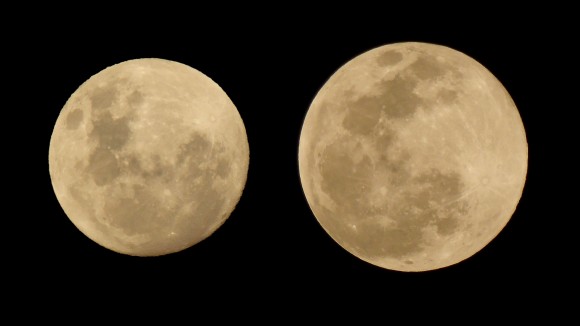What is a supermoon? We confess: before a few years ago, we in astronomy had never heard that term. To the best of our knowledge, astrologer Richard Nollecoined the term supermoon over 30 years ago. The term has only recently come into popular usage. Nolle has defined a supermoon as:
… a new or full moon which occurs with the moon at or near (within 90% of) its closest approach to Earth in a given orbit.
That’s a pretty generous definition, which is why there are so many supermoons. By this definition, according to Nolle:
There are 4-6 supermoons a year on average.
Next Supermoon December 2017
The next Supermoon will be on December 3, 2017.
The Supermoon on November 14, 2016, was the closest since January 26, 1948. The next time a Full Moon will come even closer to Earth is on November 25, 2034 (dates based on UTC time).
Super Full Moon and Super New Moon
When a Full Moon coincides with its closest approach to Earth, it is called a Super Full Moon. A New Moon that takes place when the Moon is around its perigee is known as a Super New Moon.
A Micromoon, on the other hand, is when a Full or a New Moon is farthest from the Earth, around apogee. It's also known as a Minimoon, Mini Full Moon, or a Mini New Moon
Not an Official Name
Supermoon is not an official astronomical term. It was first coined by an astrologer, Richard Nolle, in 1979. He defined it as ‘a New or a Full Moon that occurs when the Moon is at or near (within 90% of) its closest approach to Earth in its orbit’. It is not clear why he chose the 90% cut off in his definition.
There are no official rules as to how close or far the Moon must be to qualify as a Supermoon or a Micro Moon. Different outlets use different definitions. Due to this, a Full Moon classified as a Supermoon by one source may not qualify as a Super Full Moon by another.
How long does it take for the moon to go through all of its phases?
about 29.5 days It takes 27 days, 7 hours, and 43 minutes for our Moon to complete one full orbit around Earth. This is called the sidereal month, and is measured by our Moon'sposition relative to distant “fixed” stars. However, it takes our Moon about 29.5 days to complete one cycle of phases (from new Moon to new Moon).
source :
www.lpi.usra.edu/education/skytellers/moon-phases/
http://earthsky.org/astronomy-essentials/closest-supermoon-since-1948-nov-13-14-2016
Before we called them supermoons, we in astronomy called them perigean full moons. We first became familiar with the supermoon label in the year 2011 when the media used it to describe the full moon of March 19, 2011. On that date, the full moon aligned with proxigee – the closest perigee of the year – to stage the closest, largest full moon of 2011.
How long does it take for the moon to go through all of its phases?
about 29.5 days It takes 27 days, 7 hours, and 43 minutes for our Moon to complete one full orbit around Earth. This is called the sidereal month, and is measured by our Moon'sposition relative to distant “fixed” stars. However, it takes our Moon about 29.5 days to complete one cycle of phases (from new Moon to new Moon).
source :
www.lpi.usra.edu/education/skytellers/moon-phases/
http://earthsky.org/astronomy-essentials/closest-supermoon-since-1948-nov-13-14-2016
 |
| At right, the August 29, 2015 supermoon. At left, the March 5, 2015 ‘micro-moon’ – smallest full moon of the year. Photos by Peter Lowenstein in Mutare, Zimbabwe. |
Before we called them supermoons, we in astronomy called them perigean full moons. We first became familiar with the supermoon label in the year 2011 when the media used it to describe the full moon of March 19, 2011. On that date, the full moon aligned with proxigee – the closest perigee of the year – to stage the closest, largest full moon of 2011.




No comments:
Post a Comment